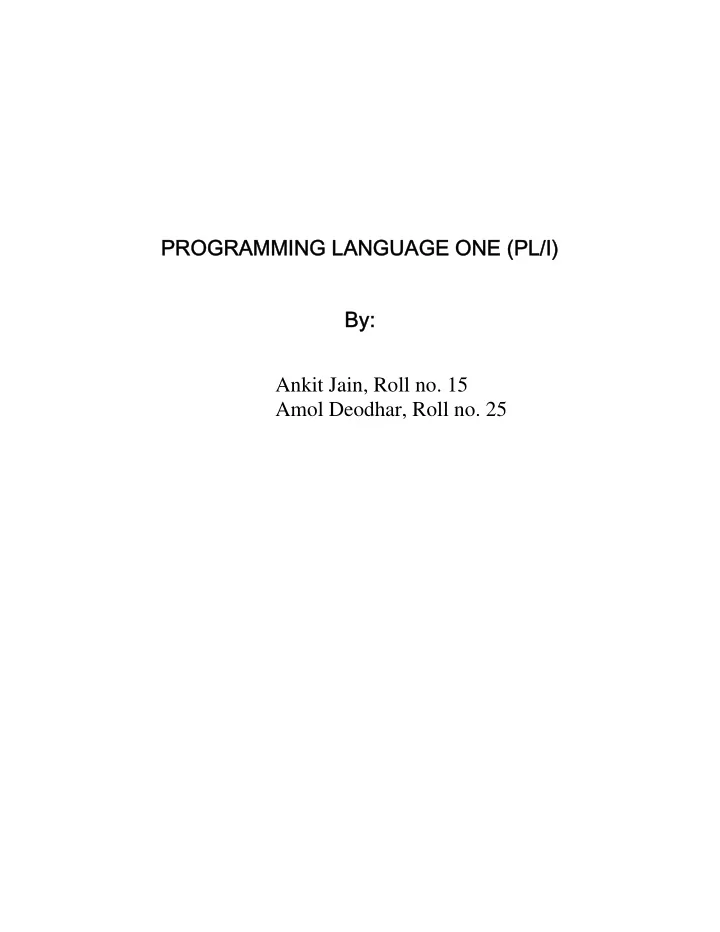

PROGRAMMING LANGUAGE ONE (PL/I) By: Ankit Jain, Roll no. 15 Amol Deodhar, Roll no. 25
History PL/1 was developed as an IBM product in the mid 1960's, and was originally named NPL (New Programming Language). The name was changed to PL/1 to avoid confusion of NPL with the National Physical Laboratory in England. If the compiler had been developed outside of the United Kingdom, the name may have remained PL/1. Until the time this new language was developed, all previous languages had focused on one particluar area of application, such as science, artificial intelligence, or business. PL/1 was not designed to be used in the same way. It was the first large-scale attempt to design a language that could be used in a variety of application areas. Significant Language Features PL/1 had the following significant language features: • PL/I is completely free form and has no reserved keywords. • It precisely defines its data types without regard for any hardware. • PL/I is a block-oriented language consisting of packages, begin blocks, and statements. This type of structure allows the programmer to produce highly- modular applications. • PL/I contains control stuctures. For example, SELECT...WHEN...OTHERWISE allow logical operations, and DO statements allow units to be executed unconditionally one time, forever, or while a condition is true or until a condition becomes true. • PL/I supports arrays, structures, unions, arrays of structures or unions, structures or unions of arrays, and combinations thereof. • PL/I provides four different storage classes: AUTOMATIC, STATIC, CONTROLLED, and BASED. Application objects' data type, representation, nature of use, etc. normally decides the type of storage class used for each.
A simple program in Pl/I EXAMPLE 1: This program demonstrates the text output function of the PL/I programming language by displaying the message "Hello world!” Source Code HELLO: PROCEDURE OPTIONS (MAIN); /* A PROGRAM TO OUTPUT HELLO WORLD */ FLAG = 0; LOOP: DO WHILE (FLAG = 0); PUT SKIP DATA('HELLO WORLD!'); END LOOP; END HELLO; EXAMPLE 2: Stripc :strips preceeding characters (e.g. blanks). StripC: proc( inStr, inChar ) returns( var char(255) ) recursive; dcl inStr char(*), inChar char; dcl substr builtin; if substr( inStr,1,1 ) = inChar then return( StripC( substr( inStr,2 ), inChar ); else return( inStr ); end StripC; PL/I has a very large vocabulary of built-in functions. In fact, there is probably no one compiler that has the full standard of keywords available. PL/I compilers are normally subsets of the language that specialize in various fields.
Partial list of features: • Preprocessing • Full support for pointers • Case-insensitive keywords • Variable-length arrays • Call by reference is the default • Supports complex structure declarations with unions • Built-in support for a slew of data types, including two types of strings • Four classes of storage: Automatic, Static, Controlled (dynamic) and Based (anonymous dynamic) • Automatic garbage collection • Built-in coprocessing facility Business users mainly used COBOL, while scientific users used Fortran. The goal of PL/I was to develop a single language usable for both business and scientific purposes. Another goal was to add structured programming constructs derived from ALGOL, which neither COBOL nor Fortran supported (at the time). PL/I was designed by a committee drawn from IBM programmers and users drawn from across the United States, working over several months. GENEALOGY of PL/I COBOL(1960) ALGOL 60(1960) FORTRAN IV(1962) PL/I (1965)
References: http://www.engin.umd.umich.edu/CIS/course.des/cis400/pl1/pl1.html#sigfeat http://hjem.get2net.dk/micrask/pli/pli.html http://home.nycap.rr.com/pflass/pli.htm http://www.users.bigpond.com/robin_v/pliwhat.htm http://en.wikipedia.org/wiki/PL/I
Recommend
More recommend